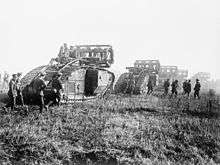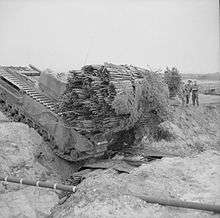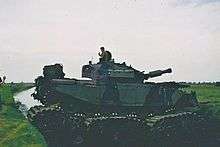Fascine

A fascine /fəˈsiːn/ is a rough bundle of brushwood or other material used for strengthening an earthen structure, or making a path across uneven or wet terrain. Typical uses are protecting the banks of streams from erosion, covering marshy ground and so on. In war they are often used to create paths for tanks and other vehicles across uneven terrain.
Early military use

Fascine bundles were used in military defences for revetting (shoring up) trenches or ramparts, especially around artillery batteries, or filling in ditches from earlier military actions. They were also used as a visual obstruction, providing cover for sappers and engineers. Military fascine bridges were used on a regular basis by the Romans to cross obstacles. Subsequently the use of fascines by military engineers continued almost wherever armies were deployed.
Military fascine in World War I and World War II


First World War tanks, namely the British Mark IV, started the practice of carrying fascines on the roof, to be deployed to fill trenches that would otherwise be an obstacle to the tank.[1] These were constructed from the traditional bundles of brushwood used to make fascines since Roman times. Although these were cumbersome to deploy they proved an effective gap crossing device and were used widely by the tanks of the day that weighed up to about 30 tons. In World War II the use of fascines continued as a gap crossing device and within the British Army these were launched from the Churchill AVRE - a Royal Engineer derivative of the standard Churchill tank (40 tons).
The Imperial Japanese Army (IJA) pre-positioned fascines made of metal pipes across the Khalkha River (between Japanese held Manchuria and Mongolia, the USSR's protectorate,) in advance of the IJA's 1939 foray into Mongolia (Nomonhan.) The use of hollow pipes had been predicated on their ability to allow water flow; the pipes were secured such that they were awash, and the river's unimpeded flow initially hid the fascines from Soviet reconnaissance aircraft. While these fascines were designed for stealth rather than combat deployment and were not deployed via armoured vehicles, the usage of hollow pipes for constructing rapid, temporary river crossings made them a significant step forward.
Modern military fascine post-World War II
The modern pipe fascine was developed in the British Army in the early 1980s to meet the challenges of assuring the mobility of movement in West Germany in the event of a NATO conflict with the Warsaw Pact.
This requirement stemmed from the terrain of West Germany where the majority of obstacles to mobility run north – south and movement by military forces would have been east – west. Thus this terrain naturally presented many obstacles to mobility. The most significant obstacles were those that would block movement of armour; primarily rivers, canals and other gaps in excess of 3m wide and more than 2m deep.[2]
The larger gaps, rivers or canals, were to be crossed using Bailey bridges or ferries. The bridges or ferries would be hand assembled on the crossing sites in the areas to the rear of the combat zone. But gaps at the forward edge had to be bridged with armoured vehicles and the bridges launched without exposing the crew. This was achieved using the AVLB (Armoured Vehicle Launched Bridge). These could bridge gaps, from 5 m – 24.5m but, due to their expense, low numbers in service and need for frequent redeployment for use on other large gaps over 10m they could not viably be used on the numerous smaller gaps, from 3 – 10m.
The problem was that within the area of operation of the British Army, near Hannover, there is a significant number of smaller gaps, mainly drainage ditches, streams and small rivers approximately 5–10 m wide and 1.5 – 2.5 m deep that are sufficient to stop armoured vehicles. Given the low number of AVLBs available a solution was needed to bridge these gaps quickly and cheaply and, if required, under fire.
In World War I similar dry gaps, i.e. large trenches, had been bridged using wooden fascines and investigations started on using modern versions of these. However it soon became clear that these were ineffective for use with the much heavier modern vehicles of up to 70 tons, 3 – 4 times heavier than World War I vehicles. The modern vehicles quickly reduced the wood in the fascines to splinters and became ineffective. Further, many of the gaps in Germany had running water in them so wooden fascines were likely to float and not stay in position. The equipment also had to have the capability to be used in rapidly bridging anti tank ditches in assault operations in other operational scenarios.
The Royal Engineers Experimental Establishment at Christchurch did initial tests on the possible use of 9” high density plastic pipes held together with chains as an alternative that would allow water flow and not be damaged with the higher modern vehicle weight.
The further development of this concept was handed over to Lt C Roebuck RE and his troop, 5 Troop, 31 Armoured Engineer Squadron, 32 Armoured Engineer Regiment at Munsterlager, North Germany in 1982. The Centurion AVRE was a Centurion tank derivative with a bulldozer blade and 165mm demolition gun fitted.


The Troop built a number of testing prototypes in Germany for development into an effective operational solution that could be accepted into service and used across the Army by both Royal Engineer and other armoured units as required. The fascines were to be launched from/with the Combat Engineer Tractor or the Centurion AVRE but also with options for deployment from other vehicles. The front of the AVRE was modified by the addition of a tilting cradle above the drivers compartment to take the fascine.
The trials involved a large number of test launches across multiple sites and a wide variety of situations to develop the structure and delivery of the fascine in operations, i.e. to find the optimum number of pipes and chain tension to create an effective level surface for vehicles in gaps, to ensure accurate deployment, rapid recovery and re deployment techniques or to test multiple launches for wider gaps. Vehicles in “shut down” combat mode and night time launches with no lights were also tested to simulate operational conditions. In “wet” gaps differing speeds and volumes of running water in the gap were tested for their impact on the fascines.
The launch technique was to approach the target gap at speed, brake sharply at a marked point and fire the explosive bolts holding the travel hawsers so that the fascine, through inertia, rolled off the AVRE directly into the middle of the gap. When in position the AVRE would then travel over it to level the road surface for other vehicles to cross. This whole process would take less than 1 minute, essential for an assault crossing possibly under fire.

Over a number of months the fascine was tested and developed, modifications were made, e.g. inserting splitable shackles in the chain holding the fascine together to allow rapid repair and tensioning, nets on the end of pipes to prevent pipes being pushed out by waterborne debris. The tests showed that with experienced drivers and crew up to 3 fascines could be launched in combination to bridge significant gaps, however this was restricted to 2 for safety reasons when using non AVRE crews. The night time testing of these was the most dangerous part of the trial with the risk of the AVRE tipping off the fascine into the gap, especially where it was a deep water gap.

After 6 months of hard work and innovative ideas from all ranks to refine the system the development trial was concluded and the final design, user hand book and acceptance recommendations were submitted by Chris Roebuck in November 1982. The fascine was subsequently accepted into service and used successfully in a number of operational and non operational roles. It was used in combat for the first time during the First Iraq war to breach anti tank ditches using the more recent Chieftain AVRE. It is now in regular use by the British Army and other armies as an effective aid to rapid crossing of small obstacles.
Currently, the British Army uses the ChAVRE - an engineering vehicle based on the Chieftain tank - to carry and deploy pipe fascines. This is due to be replaced by the Trojan, based on the Challenger 2 tank.Current 32 Armoured Engineer Regiment operation.
See also
References
External links
| Wikimedia Commons has media related to Fascines. |
- "Live and Inert Fascine Streambank Erosion Control" (PDF). (410 KiB)
- An article on use of fascines in river training for erosion control